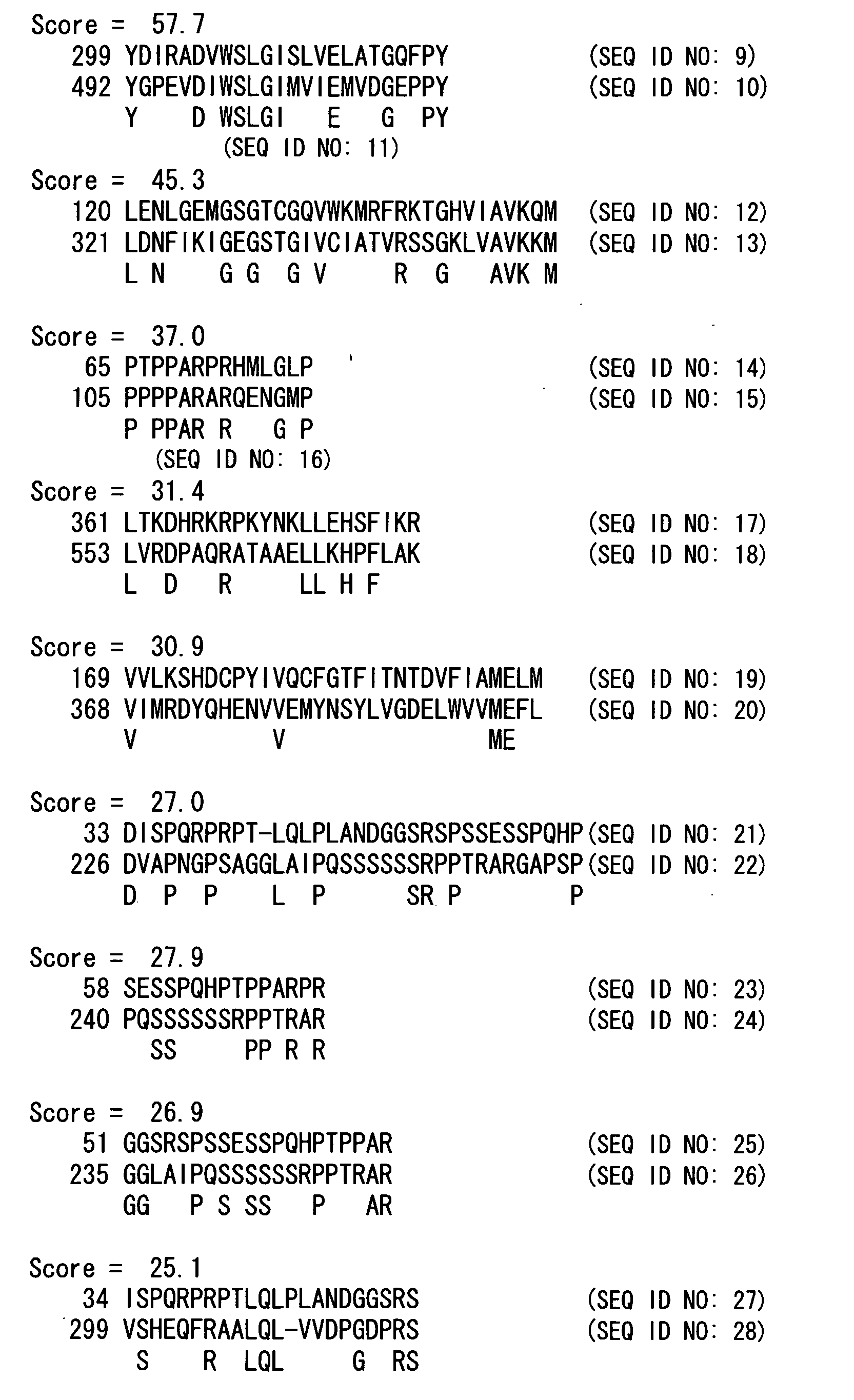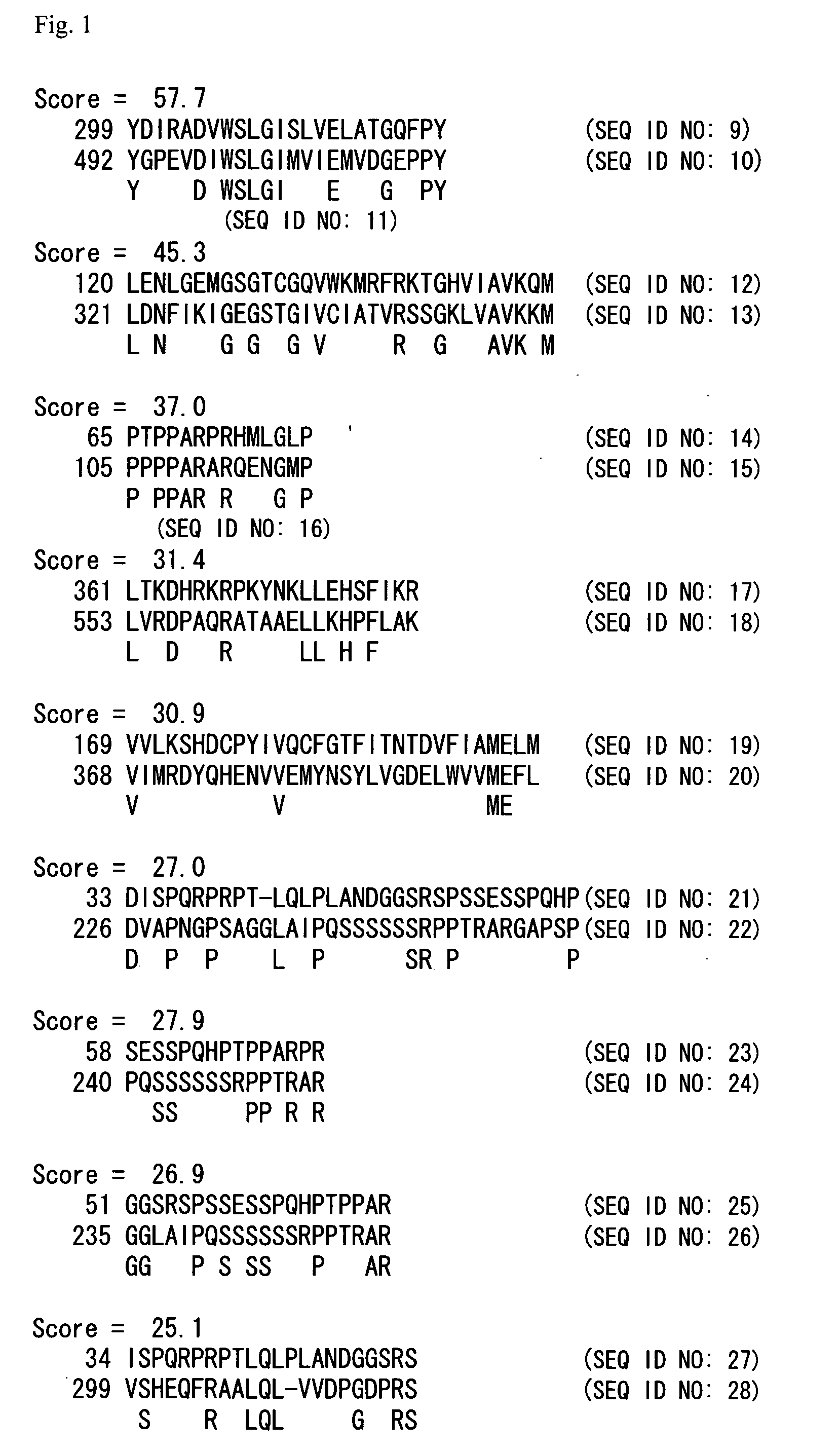Mkk7 activation inhibitor
a technology of activation inhibitor and mkk7, which is applied in the direction of peptide sources, instruments, applications, etc., can solve the problems of er stress overload and the inability to fully understand the signaling pathway between pak and jnk activation, and achieve the effect of inhibiting mkk7 activation and jnk activation
- Summary
- Abstract
- Description
- Claims
- Application Information
AI Technical Summary
Benefits of technology
Problems solved by technology
Method used
Image
Examples
example 1
In-Silico Search for Proteins Having a Function of Interacting with MKK7
[0129] The prediction of proteins having a function of interacting with MKK7 was conducted according to the method set forth in the International Patent Publication No: WO 01 / 67299. First, the amino acid sequence of MKK7 was decomposed into oligopeptides having a pre-determined length in order to search in a database for proteins having the amino acid sequence of each of the oligopeptides, or having homologous amino acid sequences to these amino acid sequences. Next, local alignment was conducted between the proteins obtained and MKK7 to identify proteins having a high local alignment score and that might be capable of interacting with MKK7.
[0130] As a result of the analysis, it was found that the oligopeptides DIWSLGI (SEQ ID NO: 3) and PPARAR (SEQ ID NO: 4), which have homology to the oligopeptides DVWSLGI (SEQ ID NO: 1) and PPARPR (SEQ ID NO: 2) that consist of seven or six amino acid residues derived from ...
example 2
Analysis of the Phosphorylation of MKK7 by PAK4
[0131] In order to experimentally determine the interaction of PAK4 with MKK7, an in-vitro phosphorylation experiment was conducted using the immune complex phosphorylation method.
[0132] A PAK4 expression plasmid was constructed as follows. First, human PAK4 cDNA was obtained from human-brain-derived poly(A)+RNA (Clontech) by a reverse transcription polymerase chain reaction (RT-PCR), and then inserted into pcDNA3.1(+) (Invitrogen) which is an expression vector for an animal cell expression system. At the time of insertion of the cDNA into the vector, a FLAG-tag coding sequence or HA-tag coding sequence was inserted at the 5′ side, and thereby there were constructed respectively an expression plasmid for an animal cell expression system comprising PAK4 ligated with FLAG-tag at its N-terminus (pcDNA-FLAG-PAK4) and comprising PAK4 ligated with HA-tag at its N-terminus (pcDNA-HA-PAK4).
[0133] Buffers comprising the following compositions...
example 3
Analysis of the Binding of PAK4 to MKK7
[0139] In order to experimentally determine the binding of PAK4 to MKK7, a binding test was conducted using the intracellular-co-expression / immuno-co-precipitation method.
[0140] For the PAK4 expression plasmid, the plasmid constructed in example 2 was used.
[0141] An MKK7 expression plasmid was constructed as follows. First, human MKK7 cDNA was obtained from human skeletal muscle-derived poly(A)+RNA (Clontech) by RT-PCR and then inserted into pcDNA3.1(+) (Invitrogen) which is an expression vector for an animal cell expression system. At the time of insertion of the cDNA into the vector, an HA-tag coding sequence was inserted at the 5′ side, and thereby an expression plasmid for an animal cell expression system of MKK7 ligated with HA-tag at its N-terminus (pcDNA-HA-MKK7) was constructed.
[0142] The buffers used in the experiments were the same in composition as those described in Example 2.
[0143] After HEK293T cells (4×105 cells in a dish wi...
PUM
| Property | Measurement | Unit |
|---|---|---|
| Disorder | aaaaa | aaaaa |
Abstract
Description
Claims
Application Information
 Login to View More
Login to View More - R&D
- Intellectual Property
- Life Sciences
- Materials
- Tech Scout
- Unparalleled Data Quality
- Higher Quality Content
- 60% Fewer Hallucinations
Browse by: Latest US Patents, China's latest patents, Technical Efficacy Thesaurus, Application Domain, Technology Topic, Popular Technical Reports.
© 2025 PatSnap. All rights reserved.Legal|Privacy policy|Modern Slavery Act Transparency Statement|Sitemap|About US| Contact US: help@patsnap.com



